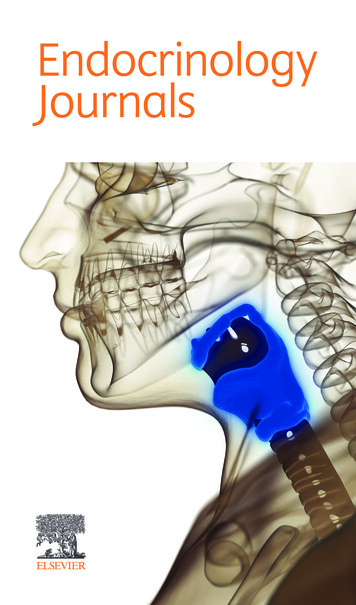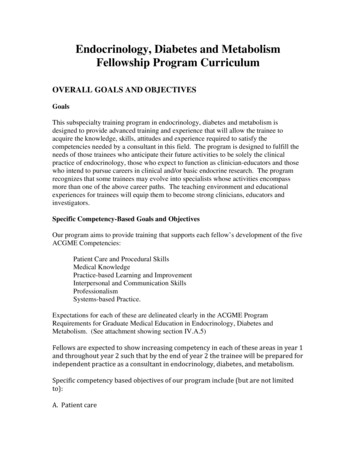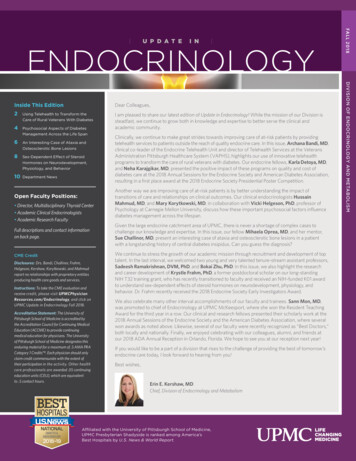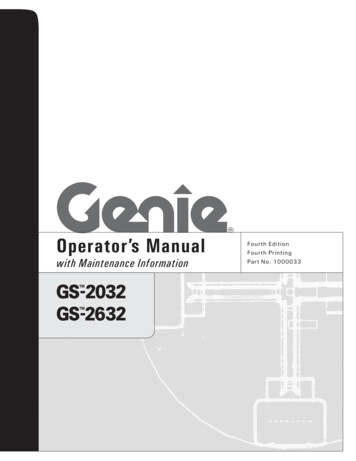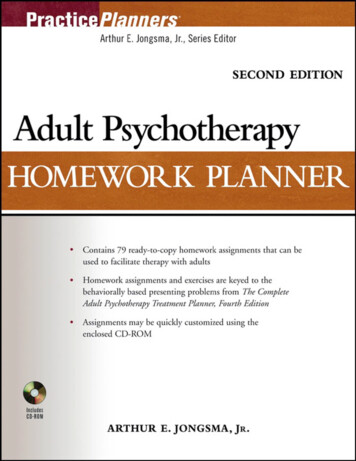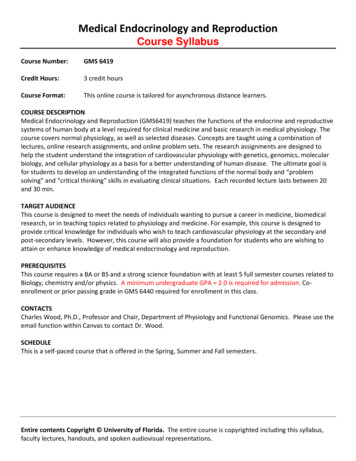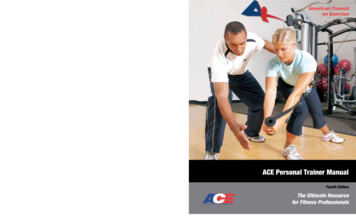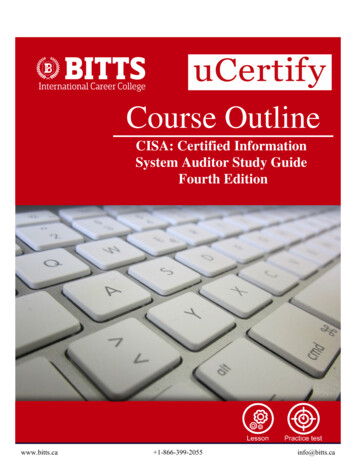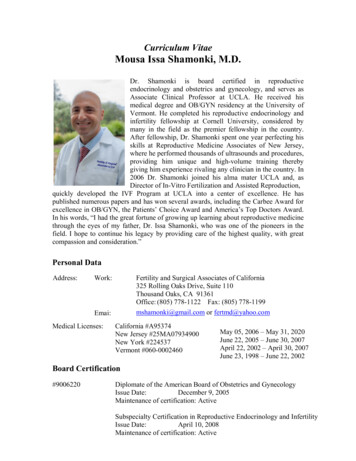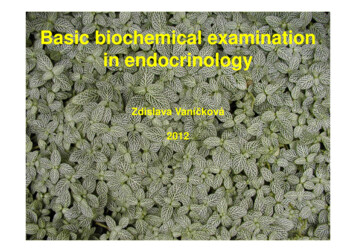
Transcription
Basic Medical EndocrinologyFourth EditioniPRELIMS-P373975.indd i6/20/2008 4:46:03 PM
Companion Web 39759Basic Medical Endocrinology, Fourth Editionby H. Maurice GoodmanResources for Professors: All figures from the book available as PowerPoint slides Links to web sites carefully chosen to supplement the content of the textbookT O O L S FOR ALLYOUR TEACHINGNEEDStextbooks.elsevier.comACADEMICPRESSTo adopt this book for course use, visit http://textbooks.elsevier.com.PRELIMS-P373975.indd ii6/20/2008 4:46:05 PM
Basic MedicalEndocrinologyFourth EditionH. Maurice GoodmanDepartment of PsychologyUniversity of Massachusetts Medical SchoolAMSTERDAM BOSTON HEIDELBERG LONDONNEW YORK OXFORD PARIS SAN DIEGOSAN FRANCISCO SINGAPORE SYDNEY TOKYOAcademic Press is an imprint of ElsevieriiiPRELIMS-P373975.indd iii6/20/2008 4:46:06 PM
Cover Credits:Background: FIGURE 3-2 Histology of the human thyroid. Simple cuboidal cells(arrows) make up the follicles. C thyroid colloid (thyroglobulin), which fills the follicles.(From Borysenko, M. and Beringer, T. (1979) Functional Histology, 312. Little, Brown,Boston by permission of Lippincott, Williams and Wilkins, Philadelphia.)Black/green: FIGURE 7-11 Confocal fluorescent microscope images of cultured mouseadipocytes that were transfected with a GLUT4-enhanced green fluorescent protein fusionconstruct and then incubated in the absence (A) or presence (B) of insulin for 30 min.Insulin stimulation results in the translocation of GLUT4 from intracellular storage sites tothe plasma membrane. (From Watson, R.T., Kanzaki, M., and Pessin, J. (2004) Regulatedmembrane trafficking of the insulin-responsive glucose transporter 4 in adipocytes. Endocr. Revs.25: 177–204, by permission of The Endocrine Society.)Blue figure: FIGURE 10-14 Low-power photomicrograph of a portion of the thyroid glandof a normal dog. Parafollicular (C) cells are indicated in the walls of the follicles. (From Ham,A.W. and Cormack, D. H. (1979) Histology, 8th Edition, 802, by permission of Lippincott,Williams and Wilkins, Philadelphia.)Red, white and blue: FIGURE 11-3 Schematic representation of the tibial epiphyseal growthplate. (Modified from Nilsson, O., Marino, R., De Luca, F., Phillip, M., and Baron, J. (2005)Endocrine regulation of the growth plate. Hormone Research 64: 157–165 by permission ofS. Karger AG, Basel.)Pink, yellow, white: FIGURE 12-1 Histological section of human testis. The transectedtubules show various stages of spermatogenesis. (From di Fiore, M.S.H. (1981) Atlas of HumanHistology, 5th Edition, 209. Lea & Febiger, by permission of Lippincott, Williams and Wilkins,Philadelphia.)Academic Press is an imprint of Elsevier30 Corporate Drive, Suite 400, Burlington, MA 01803, USA525 B Street, Suite 1900, San Diego, California 92101-4495, USA84 Theobald’s Road, London WC1X 8RR, UKCopyright 2009, Elsevier Inc. All rights reserved.No part of this publication may be reproduced or transmitted in any form or by anymeans, electronic or mechanical, including photocopy, recording, or any informationstorage and retrieval system, without permission in writing from the publisher.Permissions may be sought directly from Elsevier’s Science & Technology RightsDepartment in Oxford, UK: phone: ( 44) 1865 843830, fax: ( 44) 1865 853333, E-mail:permissions@elsevier.com. You may also complete your request online via the Elsevierhomepage (http://elsevier.com), by selecting “Support & Contact ” then “Copyright andPermission” and then “Obtaining Permissions.”Library of Congress Cataloging-in-Publication DataApplication SubmittedBritish Library Cataloguing-in-Publication DataA catalogue record for this book is available from the British Library.ISBN: 978-0-12-373975-9For information on all Academic Press publicationsvisit our Web site at www.elsevierdirect.comPrinted in China08 09 10 9 8 7 6 5 4 3 2 1PRELIMS-P373975.indd iv6/20/2008 4:46:08 PM
This volume is dedicated to my children’s children:Dylan, Adam, Rebecca, and JoshuaPRELIMS-P373975.indd v6/20/2008 4:46:08 PM
PRELIMS-P373975.indd vi6/20/2008 4:46:08 PM
ContentsList of FiguresxiiiPreface to the Fourth Edition xxviiPreface to the First EditionxxixPreface to the Second Edition xxxiPreface to the Third Edition xxxiii293131Thyrotropin-releasing hormone (TRH)Gonadotropin Releasing HormoneControl of GH SecretionCorticotropin Releasing HormoneDopamine and control of ProlactinSecretionSecretion and Actions ofHypophysiotropic Hormones363737373814FEEDBACK CONTROL OF ANTERIORPITUITARY FUNCTION3819Physiology of the PosteriorPituitary391Biosynthesis of HormonesStorage and SecretionHormones in BloodHormone DegradationMechanisms of HormoneAction48810The G-protein Coupled ReceptorsReceptors that Signal throughTyrosine KinaseMorphologyPhysiology of the AnteriorPituitary Gland29GLYCOPROTEIN HORMONESGROWTH HORMONE ANDPROLACTINADRENOCORTICOTROPIN FAMILYDEVELOPMENT OF THE ANTERIORPITUITARY GLANDREGULATION OF ANTERIORPITUITARY FUNCTIONHYPOPHYSIOTROPIC HORMONESCHAPTER 1 INTRODUCTIONSPECIFICITYCHARACTERISTICS OF RECEPTORSHORMONAL ACTIONS MEDIATEDBY INTRACELLULARRECEPTORSHORMONAL ACTIONS MEDIATED BYSURFACE RECEPTORSCHAPTER 2 PITUITARY GLAND1010111214REGULATION OF HORMONESECRETION21Negative FeedbackPositive FeedbackFeed Forward212323MEASUREMENT OF HORMONES23ImmunoassaysHormone Levels in Blood2426Suggested Reading26REGULATION OF POSTERIORPITUITARY FUNCTIONSuggested ReadingCHAPTER 3 THYROID 975.indd vii6/20/2008 4:46:08 PM
ContentsThyroid Hormones44BIOSYNTHESIS45Iodine TrappingThyroglobulin SynthesisIncorporation of Iodine454546HORMONE STORAGESECRETION4646Control of Thyroid FunctionEFFECTS OF THYROID-STIMULATINGHORMONEEFFECTS OF THE THYROID-STIMULATINGIMMUNOGLOBULINSAUTOREGULATION OF THYROID HORMONESYNTHESISThyroid Hormones in BloodMetabolism of Thyroid HormonesPhysiological Effects of ThyroidHormones484849495252Skeletal SystemCentral Nervous System5252AUTONOMIC NERVOUS SYSTEMCARDIOVASCULAR SYSTEMMETABOLISM525353Oxidative Metabolism and ThermogenesisCarbohydrate MetaboliismLipid MetabolismNitrogen Metabolism53555556CHAPTER 4 ADRENAL GLANDSMorphologyAdrenal CortexAdrenal MedullaBIOSYNTHESIS OF MEDULLARYCATECHOLAMINESSTORAGE, RELEASE, AND METABOLISMOF MEDULLARY HORMONESPHYSIOLOGICAL ACTIONS OF MEDULLARYHORMONESREGULATION OF ADRENAL MEDULLARYFUNCTIONSuggested Reading778182828686878889894950GROWTH AND MATURATIONRegulation of Thyroid HormoneSecretionMechanism of Thyroid HormoneActionSuggested ReadingGlucocorticoids and Responses to InjuryAdrenal Cortical Function During StressMechanism of Action of GlucocorticoidsRegulation of Glucocorticoid SecretionCHAPTER 5 PRINCIPLES OF HORMONALINTEGRATION91Integration of Hormonal Signals at theCellular and Molecular Level91AUGMENTATION, ANTAGONISM,AND SYNERGYPERMISSIVENESSMAINTAINING SIGNAL FIDELITYModulation of Responding SystemsSENSITIVITY AND CAPACITYSPARE RECEPTORS56A Hormonal Integration at theWhole Animal Level5759REDUNDANCYREINFORCEMENTPUSH–PULL MECHANISMS616162ADRENOCORTICAL HORMONES62Control of Adrenal Cortical Hormone SynthesisAdrenal Steroid Hormones in BloodPostsecretory Metabolism of Adrenal CorticalHormones6669Physiology of the Mineralocorticoids7169Effects of Aldosterone on the KidneyRegulation of Aldosterone Secretion7174PHYSIOLOGY OF THE GLUCOCORTICOIDS75Effects on Energy MetabolismEffects on Water BalanceEffects on Lung Development757676CHAPTER 6 HORMONES OF THEGASTROINTESTINAL TRACT91939393949697979899101Functional Anatomy of the GI Tract101Overview of Digestion and Absorption 104Hormones of the Gastrointestinal Tract 104THE GASTRIN/CHOLECYSTOKININ FAMILY105Physiological Actions of GastrinRegulation of Gastrin SecretionCholecystokinin (CCK)106108109THE SECRETIN/GLUCAGON SUPERFAMILY112Secretin114GIP (Glucose-dependent Insulinotropic Polypeptide/Gastric Inhibitory Peptide)116Glucagon-like Peptides 1 and 2 (GLP-1 and GLP-2) 118viiiPRELIMS-P373975.indd viii6/20/2008 4:46:10 PM
ContentsThe Pancreatic Polypeptide FamilyNeurotensinThe Motilin/Ghrelin FamilyConcluding CommentsSuggested Reading121122122124127FUEL CONSUMPTION153The Glucose Fatty Acid CycleAMP Activated Kinase (AMPK)153154Overall Regulation of Blood GlucoseConcentrationShort-term RegulationLong-term RegulationCHAPTER 7 THE PANCREATIC ISLETS129Morphology of the Endocrine Pancreas 129Glucagon130Integrated Actions of MetabolicHormonesADIPOSE TISSUEMUSCLELIVERPANCREATIC ISLETSBIOSYNTHESIS, SECRETION, ANDMETABOLISMPHYSIOLOGICAL ACTIONS OF GLUCAGON130130Regulation of Metabolism DuringFeeding and FastingGlucose ProductionGlycogenolysisGluconeogenesisLipogenesis and KetogenesisUreogenesis131131132133133POSTPRANDIAL PERIODPOSTABSORPTIVE PERIODFASTINGREGULATION OF GLUCAGON SECRETION134Insulin134BIOSYNTHESIS, SECRETION,AND METABOLISMPHYSIOLOGICAL ACTIONS OF INSULIN134135Effects of Insulin DeficiencyEffects on Adipose TissueEffects on MuscleEffects on Liver135137138140MECHANISM OF INSULIN ACTIONREGULATION OF INSULIN SECRETION143144GlucoseOther Circulating MetabolitesHormonal and Neural ControlCellular Events144145146146SomatostatinSuggested ReadingCHAPTER 8 HORMONAL REGULATIONOF FUEL METABOLISMGeneral Features of 59159159160160Hormonal Interactions During Exercise 162SHORT-TERM MAXIMAL EFFORTSUSTAINED AEROBIC EXERCISELong-term Regulation of Fuel StorageADIPOGENESISHYPOTHALAMIC CONTROL OF APPETITE ANDFOOD INTAKEPeripheral Input to HypothalamicFeeding and Satiety Neurons163163164165166168ADIPOSITY SIGNALS168LeptinInsulin as an Adiposity SignalAdipokinesSatiety Signals168170171172PERSPECTIVE173Suggested ReadingCHAPTER 9 REGULATION OF SALTAND WATER BALANCEGeneral ConsiderationsSalt and Water BalanceAntidiuretic Hormone (ADH)174175175176178ANTIDIURETIC EFFECTEFFECTS ON BLOOD PRESSUREREGULATION OF ADH SECRETION179180181181181182BODY FUELS151GlucoseGlycogenProteinFatProblems Inherent in the Use of Glucose andFat as Metabolic Fuels151152152152Plasma OsmolalityBlood VolumeDysfunctional States152ACTIONS OF ANGIOTENSIN IIThe -P373975.indd ix6/20/2008 4:46:10 PM
ContentsActions on the Adrenal CortexActions on the KidneyCardiovascular EffectsCentral Nervous System EffectsRegulation of the Renin-AngiotensinAldosterone SystemAtrial Natriuretic Factor (ANF)184185185185186186PHYSIOLOGICAL ACTIONS188Cardiovascular ActionsRenal ActionsEffects on Aldosterone SecretionOther Effects188189189190REGULATION OF ANF SECRETION190Integrated Compensatory Responses toChanges in Salt and Water Balance190HEMORRHAGE192Response of the Renin Angiotensin SystemResponse of the ADH SystemResponse of AldosteroneResponse of ANF192193193193DEHYDRATIONSALT LOADING AND DEPLETION193194Suggested ReadingCHAPTER 10 HORMONAL REGULATIONOF CALCIUM BALANCEGeneral Features of CalciumBalance195197198198Intestinal AbsorptionBoneKidneyPhosphorus Balance199199201202202BIOSYNTHESIS, STORAGE, AND SECRETIONOF PTHMECHANISMS OF PARATHYROID HORMONEACTIONSPHYSIOLOGICAL ACTIONS OF PTH204204Actions on BoneActions on KidneyEffects on Intestinal Absorption204205207PTH FRAGMENTSPARATHYROID HORMONE-RELATEDPEPTIDE (PTHRP)REGULATION OF PTH SECRETION207Calcitonin209210Actions on BoneActions on Kidney210210REGULATION OF SECRETION209210The Vitamin D-Endocrine System211SYNTHESIS AND METABOLISMPHYSIOLOGICAL ACTIONS OF 1,25(OH)2D3211211Actions on IntestineActions on BoneActions on KidneyActions on Parathyroid Glands212213213213REGULATION OF 1,25(OH)2D3 PRODUCTION214Calcium Regulation of Plasma CalciumConcentrations214Integrated Actions of CalcitropicHormones215RESPONSE TO A HYPOCALCEMICCHALLENGERESPONSE TO A HYPERCALCEMICCHALLENGE215216Other Hormones That Influence CalciumBalance216Suggested Reading217CHAPTER 11 HORMONAL CONTROLOF GROWTH219197DISTRIBUTION OF CALCIUM IN THE BODYCALCIUM BALANCEParathyroid Glands and ParathyroidHormone (PTH)CELLS OF ORIGINBIOSYNTHESIS, SECRETION, ANDMETABOLISMPHYSIOLOGICAL ACTIONS OF CALCITONIN203207208209Growth Hormone219SYNTHESIS, SECRETION, AND METABOLISMMODE OF ACTIONPHYSIOLOGICAL ACTIONS OF GROWTHHORMONE221221Effects on Skeletal GrowthEffects of GH/IGF-I on Body Composition222226Regulation of GH SecretionEffects of AgeRegulators of GH SecretionACTIONS OF GHRH, SOMATOSTATIN, IGF-I,AND GHRELIN ON THE SOMATOTROPEThyroid HormonesDEPENDENCE OF GH SYNTHESIS ANDSECRETION ON T3IMPORTANCE OF T3 FOR EXPRESSION OFGH ACTIONSInsulinGonadal HormonesEFFECTS OF ESTROGENS ON EPIPHYSEALGROWTH 73975.indd x6/20/2008 4:46:11 PM
ContentsEFFECTS ON GROWTH HORMONE SECRETIONAND ACTIONEFFECTS OF ANDROGENSGlucocorticoidsSuggested ReadingCHAPTER 12 HORMONAL CONTROL OFREPRODUCTION IN THE MALEMorphology of the TestesLEYDIG CELLS AND SEMINIFEROUS TUBULESMALE REPRODUCTIVE TRACTControl of Testicular FunctionLEYDIG CELLSGERMINAL EPITHELIUMTestosteroneSECRETION AND METABOLISMMECHANISM OF ACTIONEFFECTS ON THE MALE GENITAL TRACTEFFECTS ON SECONDARY SEXUALCHARACTERISTICSSexual DifferentiationDEVELOPMENT OF INTERNAL REPRODUCTIVEDUCTS AND THEIR DERIVATIVESDEVELOPMENT OF THE EXTERNAL GENITALIATESTICULAR DESCENT INTO THE SCROTUMPOSTNATAL DEVELOPMENTANOMALIES OF SEXUAL DIFFERENTIATIONRegulation of Testicular FunctionGONADOTROPIN RELEASING HORMONEAND THE HYPOTHALAMIC PULSEGENERATORNEGATIVE FEEDBACK 46246247247248250250251251251252254Inhibin and Testosterone254PREPUBERTYPUBERTY255255Suggested ReadingCHAPTER 13 HORMONAL CONTROL OFREPRODUCTION IN THE FEMALE: THEMENSTRUAL CYCLEFemale Reproductive S AND UTERUS260Ovarian INControl of Ovarian Function263263263EFFECTS OF FSH AND LH ON THEDEVELOPING FOLLICLE264Estradiol ProductionFollicular DevelopmentCellular Actions of FSH and LH264265265EFFECTS ON OVULATIONEFFECTS ON CORPUS LUTEUM FORMATIONEFFECTS ON OOCYTE MATURATIONEFFECTS ON CORPUS LUTEAL FUNCTIONEFFECTS ON OVARIAN BLOOD FLOW266266267267267Physiological Actions of OvarianSteroid Hormones267EFFECTS ON THE REPRODUCTIVE TRACTMENSTRUATIONEFFECTS ON THE MAMMARY GLANDSOTHER EFFECTS OF OVARIAN HORMONESMECHANISM OF ACTION267267269269269Regulation of the Reproductive Cycle270PATTERN OF HORMONES IN BLOOD DURINGTHE OVARIAN CYCLEREGULATION OF FSH AND LH SECRETION270271Negative Feedback AspectsSelection of the Dominant FolliclePositive Feedback AspectsNeural Control of Gonadotropin SecretionSites of Feedback Control271272273273273Timing of Reproductive CyclesSuggested ReadingCHAPTER 14 HORMONAL CONTROLOF PREGNANCY AND LACTATIONFertilization and ImplantationGAMETE TRANSPORTROLE OF THE OVIDUCTSIMPLANTATION AND THE FORMATION OFTHE PLACENTAThe PlacentaPlacental HormonesHUMAN CHORIONIC GONADOTROPIN(HCG)HUMAN CHORIONIC SOMATOMAMMOTROPIN(HCS)PROGESTERONEESTROGENSThe Role of the Fetal Adrenal CortexThe Role of Progesterone and Estrogensin Sustaining 5286xiPRELIMS-P373975.indd xi6/20/2008 4:46:11 PM
ContentsMaternal Adaptations to PregnancyCARDIOVASCULAR ADAPTATIONSRENAL ADAPTATIONS287287288Osmoregulation and Thirst289RESPIRATORY ADJUSTMENTS290Gas Exchange290METABOLIC ADJUSTMENTSCALCIUM BALANCE291291ParturitionTHE ROLE OF CORTICOTROPIN RELEASINGHORMONE (CRH)THE ROLE OF OXYTOCINLactationGROWTH AND DEVELOPMENT OF THEMAMMARY GLANDSMILK PRODUCTION292293295295296296LACTATION AND MATERNAL CALCIUMBALANCEMECHANISM OF PROLACTIN ACTIONNEUROENDOCRINE MECHANISMS296297298Milk Let-Down ReflexCellular Actions of OxytocinControl of Prolactin Secretion298298298CELLULAR REGULATION OF PROLACTINSECRETIONPROLACTIN IN BLOODLACTATION AND RESUMPTION OF OVARIANCYCLES300300301Suggested Reading301Index303xiiPRELIMS-P373975.indd xii6/20/2008 4:46:12 PM
List of FiguresCHAPTER 1Fig. 1.Fig. 2.Fig. 3.Fig. 4.Fig. 5.Fig. 6.Fig. 7.Fig. 8.Fig. 9.Fig. 10.Fig. 11.Fig. 12.Fig. 13.Fig. 14.Fig. 15.Fig. 16.Fig. 17.Fig. 18.Fig. 19.Fig. 20.Fig. 21.Fig. 22.Fig. 23.Fig. 24.Fig. 25.Fig. 26.Fig. 27.Fig. 28.Fig. 29.Chemical communication between cells.Levels at which hormone actions are considered.Composition of DNA.Complementary base pairing.Transcription and RNA processing.Alternative splicing.Translation: Alberts et al. Molecular Biology of the Cell, New York: GarlandPublishing, 1994; reprinted by permission of Garland Publishing, Inc.Post-translational processing.Exocytosis.Hormone binding to plasma proteins.Specificity of hormone signaling.Receptor components.General scheme of steroid hormone action.Schematic view of a nuclear receptor.Activation of steroid hormone receptors.An unactivated G-Protein coupled receptor.Activation of G-protein coupled receptor.Formation and degradation of cyclic adenosine monophosphate(cyclic AMP).Formation of inositol 1,4,5 triphosphate (IP3) and diacylglycerol (DAG).Effects of cyclic AMP.(IP3) diacylglycerol/(DAG) second messenger system.DAG lipase to releases precursors of the prostaglandins and leukotrienes.Signaling through tyrosine kinase.Signaling through JAK/Stat.Components of a hormone response system.Negative feedback of hepatic glucose production by glucagon.Negative feedback regulation of blood glucose concentration by insulin andglucagon.Positive feedback regulation of oxytocin secretion.Competing reactions that form the basis of the radioimmunoassay.xiiiPRE4-P373975.indd xiii6/19/2008 4:44:28 PM
List of FiguresFig. 30. Sandwich type assay.Fig. 31. Patterns of hormone concentrations in blood: A. Bremer et al., J. Clin Endocrinol. Metab., 56: 1278,1983; reprinted by permission of the Endocrine Society; B. Yamaji et al., Endocrinology, 90: 771,1972; reprinted by permission of the Endocrine Society; C. Hwang et al., Proc. Natl. Acad. Sci. USA,68: 1902–1971, reprinted with permission.CHAPTER 2Fig. 1.Fig. 2.Fig. 3.Fig. 4.Fig. 5.Fig. 6.Fig. 7.Fig. 8.Fig. 9.Fig. 10.Fig. 11.Human pituitary gland and adjacent hypothalamic structures: Netter, F.H., Atlas of HumanAnatomy, 2nd ed. Novartis Summit New Jersey; reprinted by permission of Elsevier.Vascular supply of the human pituitary gland: Netter, F.H., Atlas of Human Anatomy, 2nd ed.Novartis Summit New Jersey; reprinted by permission of Elsevier.The glycoproteins.The growth hormone/prolactin family.Proteolytic processing of pro-opiomelanocortin (POMC).Development of the principal cell types of the anterior pituitary gland.Midsagittal section of the human hypothalamus and pituitary: Netter, F.H., Atlas of HumanAnatomy, 2nd ed. Novartis Summit New Jersey; reprinted by permission of Elsevier.Regulation of anterior pituitary hormone secretion.Structures of the neurohypophysial hormones.Regulation of oxytocin secretion.Regulation of vasopressin secretion.CHAPTER 3Fig. 1.Fig. 2.Fig. 3.Fig. 4.Fig. 5.Fig. 6.Fig. 7.Fig. 8.Fig. 9.Fig. 10.Fig. 11.Gross anatomy of the thyroid gland: Netter, F.H., Atlas of Human Anatomy, 2nd ed. Novartis SummitNew Jersey; reprinted by permission of Elsevier.Histology of the human thyroid.Thyroid hormones: Braverman, L.E., and Utiger, R.D., eds. Werner and Ingbar’s The Thyroid, 8th ed.,Lippincott Williams and Wilkins, Philadelphia; reprinted by permission of Lippincott, Williams andWilkins, Philadelphia.Thyroid hormone biosynthesis and secretion: Balasse, P.D., Rodesch, F.R., Neve, P.E. et al. (1972)C. R. Acad .Sci. [D] (Paris), 274: 2332; reprinted by permission of Publies Avec Le Concours DuCentre National.Hypothetical coupling scheme for intramolecular formation of T4.Scanning electron micrographs of the luminal microvilli of dog thyroid.Rate of loss of serum radioactivity after injection of labeled T4 or T3.Metabolism of thyroxine.Effects of thyroid therapy on growth and development of a child: Wilkins, L. (1965) The Diagnosisand Treatment of Endocrine Disorders in Childhood and Adolescence, Charles C. Thomas, Springfield,Illinois; reprinted by permission of Charles C. Thomas Publishing.Effects of thyroxine on oxygen consumption by various tissues: Barker, S.B. and Klitgaard, H.M.(1952) Metabolism of tissues excised from thyroxine-injected rats. Am. J. Physiol. 170: 81; reprintedby permission of the American Physiological Society.Effects of glucose and T3 on the induction of malic enzyme (ME): Mariash, G.N. andOppenheimer, J.H. (1982) Thyroid hormone-carbohydrate interaction at the hepatic nuclearlevel Fed. Proc., 41: 2674; reprinted by permission of the Federation of American Societies forExperimental Bio (FASEB).xivPRE4-P373975.indd xiv6/19/2008 4:44:30 PM
List of FiguresFig. 12. Feedback regulation of thyroid hormone secretion.Fig. 13. Effects of TRH, T3, and T4 on the thyrotrope.Fig. 14. Effects of on the response to thyrotropin releasing hormone (TRH): Snyder, P.J., and Utiger, R.D.(1972) Inhibition of thyrotropin response to thyrotropin-releasing hormone by small quantitiesof thyroid hormones. J. Clin. Invest. 52: 2077; reprinted by permission of the American Society ofClinical Investigation.Fig. 15. Models of the Effects of thyroid hormone receptor (TR) on gene transcription.CHAPTER 4Fig. 1. Anatomy and histology of the adrenal glands.Fig. 2. The principal adrenal steroid hormones.Fig. 3. Conversion of cholesterol to pregnenolone.Fig. 4. Biosynthesis of adrenal cortical hormones: Rainey, W.E., Carr, B.R., Sasano, H., Suzuki, T., andMason, J.I. (2002) Dissecting human adrenal androgen production. 760. Trends in Endocrinology and Metabolism 13: 234–239; reprinted bypermission of Elsevier.Fig. 5. The principal estrogens.Fig. 6. Stimulation of steroidogenesis by ACTH in zona fasciculata cells.Fig. 7. Plasma concentrations of cortisol and dehydroepiandrosterone sulfate.Fig. 8. Stimulation of aldosterone synthesis by angiotensin II (AII).Fig. 9. The cortisol-cortisone shuttle.Fig. 10. Oxidation of cortisol to cortisone prevents binding to mineralocorticoid receptor.Fig. 11. Hemiacetal protects aldosterone from oxidation by HSD.Fig. 12. Extra-adrenal synthesis of testosterone and estrogens from DHEAS.Fig. 13. Effects of continuous administration of aldosterone to a normal man: August, J.T., Nelson, D.H.,Thorn, G.W. (1958) Response of normal subjects to large amounts of aldosterone. J. Clin. Invest. 37:1549 1559; reprinted by permission of the American Society of Clinical Investigation.Fig. 14. Proposed mechanisms of action of aldosterone in the kidney.Fig. 15. Dual negative feedback control of aldosterone secretion.Fig. 16. Effects of glucocorticoids on metabolism of body fuels.Fig. 17. Synthesis and structures of some arachidonic acid metabolites.Fig. 18. Effects of interleukin -1(IL-1).Fig. 19. Anti-inflammatory actions of cortisol.Fig. 20. Cortisol inhibits proliferation of T cells.Fig. 21. Negative feedback control of glucocorticoid secretion.Fig. 22. Hormonal interactions that regulate ACTH secretion by pituitary corticotrope.Fig. 23. Plasma concentrations of ACTH and cortisol at different times of day: Matsukura, S., West, C.D.,Ichikawa, Y., Jubiz, W., Harada, G., Tyler, F.H. (1971). A new phenomenon of usefulness in theradioimmunoassay of plasma adrenocorticotropic hormone. J. Lab. Clin. Med., 77: 490–500;reprinted by permission of Elsevier.Fig. 24. Feedback regulation of the hypothalamic-pituitary-adrenal axis by cytokines.Fig. 25. Consequences of a partial block of cortisol production.Fig. 26. Biosynthesis of epinephrine and norepinephrine in adrenal medullary cells.Fig. 27. Catecholamine degradation: Cryer. In: Endocrinology and Metabolism, 2nd ed., edited byFelig et al. McGraw Hill, New York, 1987; with permission of the McGraw-Hill Companies.Fig. 28. Secretion of epinephrine and norepinephrine in response to hypoglycemia: Garber, A.J.,Bier, D.M., Cryer, P.E., Pagliara, A.S. (1976) Hypoglycemia in compensated chronic renalinsufficiency. Substrate limitation of gluconeogenesis. J. Clin. Invest. 58: 7–15; reprinted bypermission of the American Society of Clinical Investigation.xvPRE4-P373975.indd xv6/19/2008 4:44:30 PM
List of FiguresCHAPTER 5Fig. 1.Fig. 2.Fig. 3.Fig. 4.Fig. 5.Fig. 6.Fig. 7.Fig. 8.Fig. 9.Fig. 10.Fig. 11.Fig. 12.Fig. 13.Integration at the cellular level.Synergistic effects of growth hormone and glucocorticoid: Gorin, E., Tai, L.R., Honeyman, T.W.,and Goodman, H.M. (1990) Evidence for a role of protein kinase C in the stimulation of lipolysis bygrowth hormone and isoproterenol. Endocrinology 126: 2973, 1990; reprinted by permission of theEndocrine Society.Determinants of the magnitude of a hormonal response.Determinants of the duration of a hormonal response.Relationship between concentration and response at different sensitivities.Concentration response relationships showing different capacities to respond.Effects of receptor number on sensitivity to hormonal stimulation.Spare receptors.Redundant mechanisms to stimulate hepatic glucose production.Redundant mechanisms to activate glycogen phosphorylase.Effects of epinephrine and growth hormone on plasma free fatty acids.Push:pull mechanism.Push:pull mechanism on glycogen phosphorylase and glycogen synthase.CHAPTER 6Fig. 1. The gastrointestinal tract.Fig. 2. Gastric glands.Fig. 3. Schematic representation of the enteric nervous system: Johnson, L.R., Essential MedicalPhysiology, 3rd ed., Elsevier, Academic Press, San Diego, 2003, p. 469; reprinted by permission ofElsevier.Fig. 4. Vago-vagal reflexes.Fig. 5. Progastrin, procholecystokinin(CCK), and their posttranslational processing.Fig. 6. Stimulation of gastric acid secretion.Fig. 7. Cellular actions of gastrin, acetylcholine and histamine on the parietal cell.Fig. 8. Actions of gastrin and PACAP in ECL cells.Fig. 9. Direct and indirect feedback regulation of gastrin secretion.Fig. 10. Somatostatin (SST) secretion in the gastric mucosa.Fig. 11. Effects of a meal on secretion of cholecystokinin, gall bladder contraction, and pancreaticchymotrypsin: Liddle, R.A., Goldfine, I.D., Rosen, M.S., Taplitz, R.A., and Williams, J.A.,Cholecystokinin activity in human plasma. molecular forms, responses to feeding. And relaionshipto gall bladder contraction, J. Clin. Invest. 75: 1144–1152, 1985; reprinted by permission of theAmerican Society of Clinical Investigation and Owyang, C., Louie, D.S., and Tatum, D. Feedbackregulation of pancreatic enzyme secretion. Suppression of cholecyctokinin release by trypsin.J. Clin. Invest. 77: 2042–2047, 1986; reprinted by permission of the American Society of ClinicalInvestigation.Fig. 12. Actions of CCK on pancreatic secretion and bile flow.Fig. 13. Regulation of CCK secretion.Fig. 14. The secretin/glucagon family of peptides.Fig. 15. Effects of secretin on bicarbonate secretion by pancreatic and bile ducts.Fig. 16. Synergistic effects of secretin and CCK on bicarbonate secretion: Refeld, J.F., Best Practice andResearch in Clinical Endocrinology and Metabolism 18: 569–586, 2004; reprinted by permission ofElsevier.Fig. 17. Actions of secretin and feedback regulation of its secretion.xviPRE4-P373975.indd xvi6/19/2008 4:44:31 PM
List of FiguresFig. 18. The incretin effect: McIntyre, N., Holdsworth, C.D., and Turner, D.S. Intestinal Factors in the controlof insulin secretion. J. Clin. Endocrinol. Metab. 25: 1317–, 1965; reprinted by permission of theEndocrine Society.Fig. 19. Effects of nutrients on secretion of incretin hormones: Elliott, R.M., Morgan, L.M., Tredger, L.A.,Deacon, S., Wright, J., Marks, V., Glucagon-like peptide-1 (7–36)amide and glucose-dependentinsulinotropic polypeptide secretion in response to nutrient ingestion in man: acute post-prandialand 24-h secretion patterns. J. Endocrinol. 138: 162, 1993; reprinted by permission of the Society ofEndocrinology.Fig. 20. Post-translational processing of proglucagon.Fig. 21. Effects of GLP-1 gastric emptying and acid: Nauck, M.A., Niedereichholz, U., Ettler, R., Holst, J.J.,Orskov, C., Ritzel, R., Schmiegel, W.H., Glucagon-like peptide 1 inhibition of gastric emptyingoutweighs its insulinotropic effects in healthy humans. Am. J. Physiol. Endocrinol. Metab. 273:E981 E988, 1997; reprinted by permission of the American Physiological Society.Fig. 22. The ileal brake.Fig. 23. Amino acid sequences of the PPY (PPfold) family of peptides.Fig. 24. Effects of test meals on plasma concentrations of neurotensin.Fig. 25. The motilin ghrelin family: Rosell, S. and Rökaeus, Ä. The effect of ingestion of amino acids, glucoseand fat on circulating neurotensin-like immunoreactivity (NTLI) in man. Acta. Physiol. Scand. 107:263 267, 1979; reprinted by permission of Wiley-Blackwell Publishing.Fig. 26. Effects of motilin on gastric muscle tone: Cuomo, R. Vandaele, P., Coulie, B., Peeters,T.,Depoortere, I., Janssens, J., an Tack, J., Influence of motilin on gastric fundus tone and onmeal-induced satiety in man: role of cholinergic pathways. Am. J. Gastroenterol. 101: 804–811,2006; reprinted by permission of Wiley-Blackwell Publishing.Fig. 27. Average plasma ghrelin concentrations during a 24-h period: Cummings, D.E., Purnell, J.Q.,Frayo, R.S., Schmidova, K., Wisse, B.E., and Weigle, D.S. A preprandial rise in plasma ghrelinlevels suggests a role in meal initiation in humans. Diabetes 50: 1714 1719, 2001; reprinted bypermission of Elsevier.CHAPTER 7Fig. 1.Fig. 2.Fig. 3.Fig. 4.Fig. 5.Fig. 6.Fig. 7.Fig. 8.Fig. 9.Fig. 10.Fig. 11.Fig. 12.Fig. 13.Fig. 14.Cytoarchitecture of a typical human pancreatic islet: Cabrera, O., Berman, D.M., Kenyon, N.S.,Ricordi, C., Berggren, P.O., and Caicedo, A. (2006) The unique cytoarchitecture of human pancreaticislets has implications for islet cell function. Proc. Nat. Acad. Sci. USA 103: 2334 2339; Copyright2006: National Academy of Sciences, USA.Biochemical pathways of glucose metabolism in hepatocytes.Role of protein kinase A in glycogen metabolism.Regulation of fructose-1,6-bisphosphate metabolism by protein kinase A.Regulation of phosphoenol pyruvate (PEP) formation by protein kinase A.Protein kinase A indirectly stimulates ketogenesis.Stimulatory and inhibitory signals for glucagon sec
Basic Medical Endocrinology Fourth Edition H. Maurice Goodman Department of Psychology University of Massachusetts Medical School AMSTERDAM BOSTON HEIDELBERG LONDON NEW YORK OXFORD PARIS SAN DIEGO SAN FRANCISCO SINGAPORE
